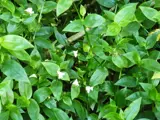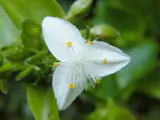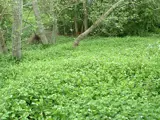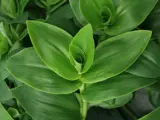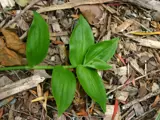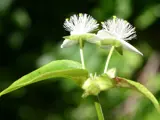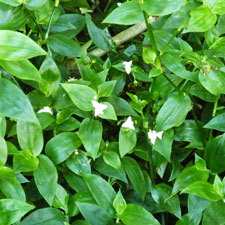 Tradescantia
Tradescantia
Common name: Wandering willie; Wandering Jew
Botanical name: Tradescantia fluminensis
Management programme: Advisory
Originally from south-east Brazil and Argentina. Was naturalised in New Zealand in 1916. Introduced as an ornamental plant due to its ability to grow almost anywhere – very popular as a hanging plant.
Why is it a pest?
- Can rapidly invade light gaps but prefers cool moist and shaded conditions.
- Creeping mat-forming habit and resprouts rapidly from shoot fragments after physical damage and grazing.
- Prevents the seedlings of native species from establishing.
- Causes habitats to open and be invaded by exotic shrubs and vines.
- Mats growing on riverbanks can break away with water flow, starting new infestations downstream, and contribute to flooding.
- Very tolerant of dense shade, wet, most soil types and high to low temperature but is susceptible to frost and drought.
- Causes dermatitis in dogs and other animals.
Where is it found?
Tradescantia thrives in forest, gardens, scrub and forest margins, cliffs, bluffs, and riverbed/streamside environments and downstream or adjacent to existing infestations. It is widespread in the Bay of Plenty.
What does it look like?
- Fleshy long-lived perennial plant with trailing stems that produce roots at their joints.
- Has shiny leaves with dark green upper surfaces and often slightly purplish undersides.
- Leaves (3-6mm long) are alternately arranged along the stems and have sheathed bases.
- Has white flowers (about 2 cm across) that have three pointed petals in small clusters near the tip of the branches.
- Flowers December to January.
What are the rules?
Advisory
Council does not enforce the control of advisory species. It is landowner/occupier responsibility to manage these pests. Council may provide advice on how to manage or control advisory species if required.
How do you get rid of it?
- Cover with Weedmat or black plastic for several months.
- Rake or hand-pull during drought conditions. Burn, bury or dispose of at the general waste section of local refuse transfer station. Usually needs a spray follow-up.
- Spray with herbicide. Follow up 2-3 months later. Several spray treatments required for total control.
All remaining stem fragments re-sprout. Exclude livestock at all times. Do not replant until site is clear.
CAUTION: When using any herbicide or pesticide, PLEASE READ THE LABEL THOROUGHLY to ensure that all instructions and directions for the purchase, use and storage of the product, are followed and adhered to.
Read more on pest control advice, information and regulations
Images

